Gigabyte GA-P55M-UD4 - P55 uATX Goodness
by Gary Key on July 24, 2009 12:00 AM EST- Posted in
- Gary's First Looks
pro·gres·sive - 1 a: of, relating to, or characterized by progress b: making use of or interested in new ideas, findings, or opportunities... The introduction of the first uATX P55 based motherboard by Gigabyte indicates progressive thinking on their part. I have to admit it, I am a big fan of the uATX form factor. So my enthusiasm about this particular product has me acting like a kid on Christmas morning. We did not know if Gigabyte would proceed forward with this design or not. However, we are excited they did and can now show what was displayed to us at Computex 2009.
I was excited to see the X58 uATX form factor boards launch earlier this year and now that we have the EVGA board in-house for testing, expect to see a X58 mini-roundup in the near future. That said, I really think the P55/Lynnfield setup is a better choice for the uATX form factor than the X58/ICH10R/i7 combination due to the single chip design, lower power consumption numbers, cost, and of course performance that is almost on par if not better at times than its big brother. We cannot discuss the actual performance of the GA-P55M-UD4, but it will ship with a BIOS that is performance oriented. Based on the components utilized and board design, expect it to perform like its ATX siblings.
So let's take a quick look around the board and as always, Gigabyte welcomes your comments.
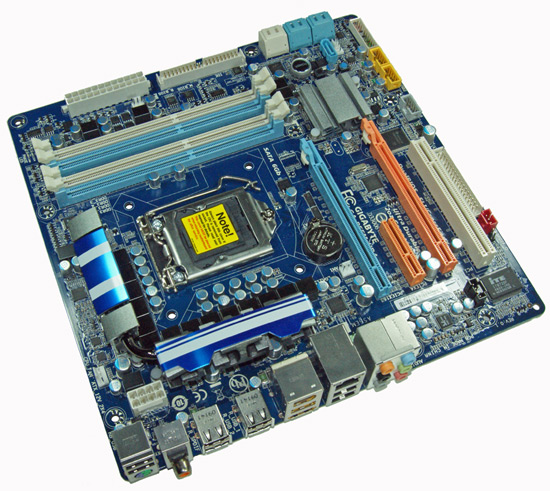
Considering the limited board space, Gigabyte did a very good job fitting all of the peripherals onto this board. About the only negatives we can think of is the continued inclusion of the floppy drive port. We think that space is better utilized for the power, reset, and clear CMOS buttons currently located in front of the SATA ports. Also, swapping the PCI and PCIe x4 slots works better for us due to our peripheral needs. The GA-P55M-UD4 fully supports both CrossFire and SLI operation. The board also sports four fan headers and the ICS 9LPRS914EKLF PLL clock generator.
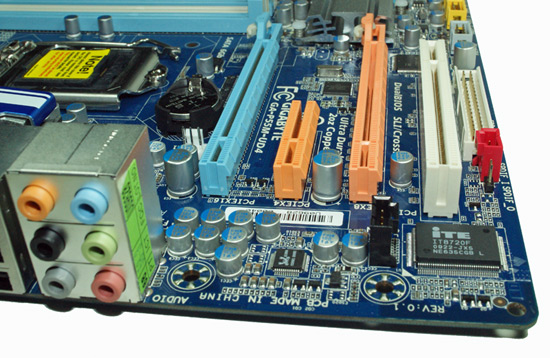
Gigabyte includes two PCIe x16 slots (x8 dual operation, Lynnfield based), PCIe x4 (P55) slot, and a PCI slot. Obviously, both the PCIe x4 and PCI slots will be unavailable when utilizing a dual slot video card.
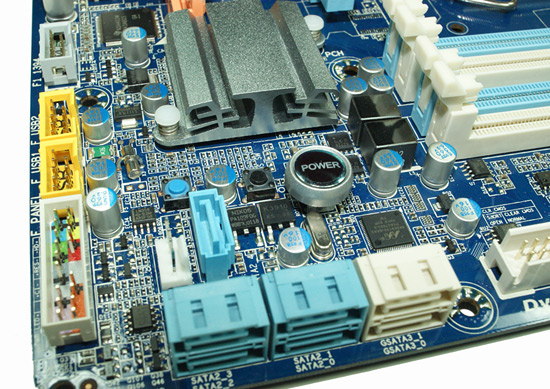
There are five (blue) SATA 3Gb/s ports provided by the P55 chipset that support RAID 0, 1, 5, 10. The sixth port available on the P55 (under the silver heatsink) is utilized on the I/O panel for eSATA. On our particular sample, Gigabyte included the Marvell 88SE9123 6Gb/s SATA chip that drives the two white SATA ports and provides IDE support. Whether or not this chipset will be utilized at launch is up in the air depending on when the respin of the chipset is completed or if a single chip implementation on boards like this will be fine based on current test results.
Also located in this area is the power, reset, and clear CMOS switches. We would have preferred that the floppy drive port be dropped and the switches moved to that location. When installing a secondary graphics card with a dual slot cooler, these buttons are difficult to use. The control panel header, two USB 2.0 (four ports total) headers, and the IEEE 1394a header are located on the edge of the board.
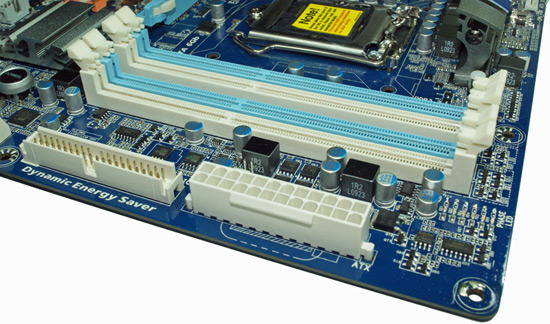
The IDE port, 24-pin ATX power connector, and the four DIMM slots are located in the lower right hand corner of the board. This board supports dual channel memory configurations and 16GB of DDR3 memory when using 4GB DIMMS. Installing the memory with a video card inserted in the first slot is difficult but not impossible.
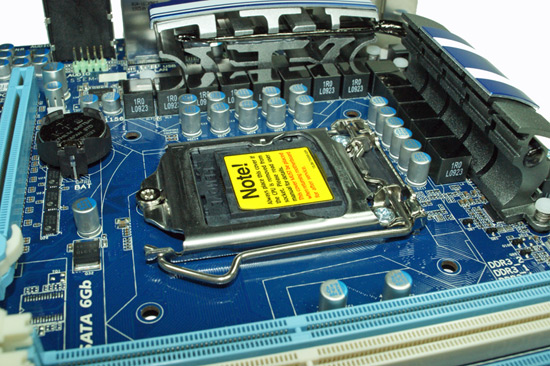
The CPU area is open for the most part and will accommodate larger coolers like the Thermalright Ultra 120 Extreme. The various capacitors and battery are located near the S1156 socket and will pose some problems for the more extreme clockers if they decide to use this board.
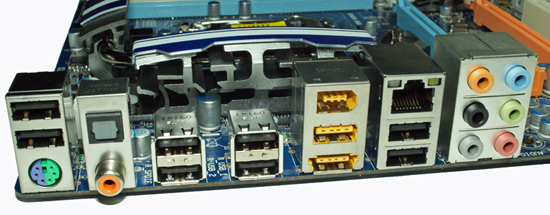
Last but not least is the I/O panel. We have eight USB 2.0 ports (total of twelve on the board), combination PS/2 port, self powered eSATA port, IEEE 1394a port offered by the TI TSB43AB23 chipset, Gigabit Ethernet LAN port via the Realtek RTL8111D chipset, optical out/coaxial out S/PDIF ports, and the audio panel that provides 8-channel audio output via the Realtek ALC 889a HD codec.
















34 Comments
View All Comments
strikeback03 - Monday, July 27, 2009 - link
I wouldn't be at all surprised if more people make use of the FireWire than would of a different Ethernet solution. Your average home server user won't know the difference, and obviously these aren't going into business servers.Piyono - Saturday, July 25, 2009 - link
My thoughts exactly.GeorgeH - Friday, July 24, 2009 - link
Putting the battery that close to a heat source makes me wonder about its longevity.I'm sure Gigabyte's engineers have already run the numbers and found the heat to be acceptable, but it still looks like sloppy design at first glance.
garydale - Friday, July 24, 2009 - link
While KVMs are gradually becoming more diverse in their capabilities, I use two older models at my work locations, each of which is set up for PS/2 keyboards and mouses. I don't see any need to update them since they both continue to work, as do the keyboards and mouses I use with them.And my 21" CRT that I run at 1792 x 1344 (19" at 1600 x 1200 at the other desk) still can't be economically replaced with an LCD display that can handle a similar resolution not to mention colour gamut. If I replace the monitor(s), then the keyboard/mouse and KVM devices also will probably be replaced to allow use of the DVI port.
However, until then, I continue to demand PS/2 ports for keyboard and mouse. Dropping the second PS/2 port to add a couple more USB ports seems pointless. Just how many USB devices do you really need to plug in at the back anyway? I find a greater need for more at the front, but either location can be upgraded with an add-on USB hub if you really need more.
The last mainboard I bought was a Gigabyte and the deciding factor was the second PS/2 port. ASUS didn't have a similar model with 2 PS/2 ports (I know there are other good manufacturers out there, but Gigabyte and ASUS are the easiest to find in my area, with MSI also being reasonably available. Others I have to hunt for or special order).
So please Gigabyte, keep the PS/2 ports. Drop the floppy and consider ditching the IDE connector too.
kmmatney - Saturday, July 25, 2009 - link
It looks like the lone PS/2 port handles both a keyboard and mouse (with a splitter cable), so you are not losing anything. You can get these PS/2 splitter cables easily online for cheap.garydale - Monday, July 27, 2009 - link
Thanks for the comments. However I still don't like the idea for a few reasons. Firstly, the adapter is an "add-on" that will be dangling from the back of the machine. This makes it more easily dislodged that the normally recessed PS/2 ports. Secondly, there is now an extra connection that needs to be made for the devices to work. Thirdly, the keyboard and mouse connections on these adapters are usually not colour coded and the keyboard and mouse connectors are NOT interchangeable. I've even heard of the ports being mislabelled and in some cases they aren't labelled.As for the PS/2 to USB adapters, these can be somewhat problematic. They may or may not work since the signalling is different between the devices. The better ones that actually convert the signals aren't all that expensive ($20 - $40) but they do have a non-negligible cost.
Putting two PS/2 ports on the mainboard instead of the USB ports is almost certainly cheaper for the manufacturer. However they seem obsessed with advertising ridiculous numbers of USB ports.
You can get a bracket giving you 4 extra USB ports for about $10.00 if you really need them. Since manufacturers often provide a 2-port bracket, they could easily give us back the separate PS/2 ports and put the two additional USB ports on the included bracket, making it a 4 port.
DigitalFreak - Friday, July 24, 2009 - link
You can buy a PS/2 to USB adapter cable for peanuts nowadays. Some of the Dell servers we had at my last job had no PS/2 ports at all, and our KVM switches were PS/2 only. The adapter worked great.I'd like to see them get rid of ALL legacy ports (floppy, IDE, PS/2). It's way past due.
Mr Perfect - Friday, July 24, 2009 - link
What DigitalFreak said. The Dell Poweredges we've been bought haven't had PS2 ports for over two years now. A PS2 to USB adapter and they work just fine with old KVMs.Lonyo - Friday, July 24, 2009 - link
It makes sense to go with that layout to me, assuming you can utilise the second PCIe slot with whatever you want.If they put the PCI slot under the PCIe x16 slot 1 and you used a dual slot card you would have no PCI slot at all.
With that layout it means you can have a dual slot card in PCIe x16 slot 1 and then a PCI card in the PCI slot, and use the PCIe x16 slot 2 for another expansion card, even though you lose the x4 slot. It means 1 PCIe and 1 PCI slot available if you use a single dual slot card.
If you switch the x4 and PCI you get 2xPCIe and no PCI.
RagingDragon - Monday, July 27, 2009 - link
But, if I use the second 16X card for my 1X sound card, will my graphics card be limited to 8X? Do I have the option to use the 16X slots as 16X + 1X or can they only be used as 8X + 8X?